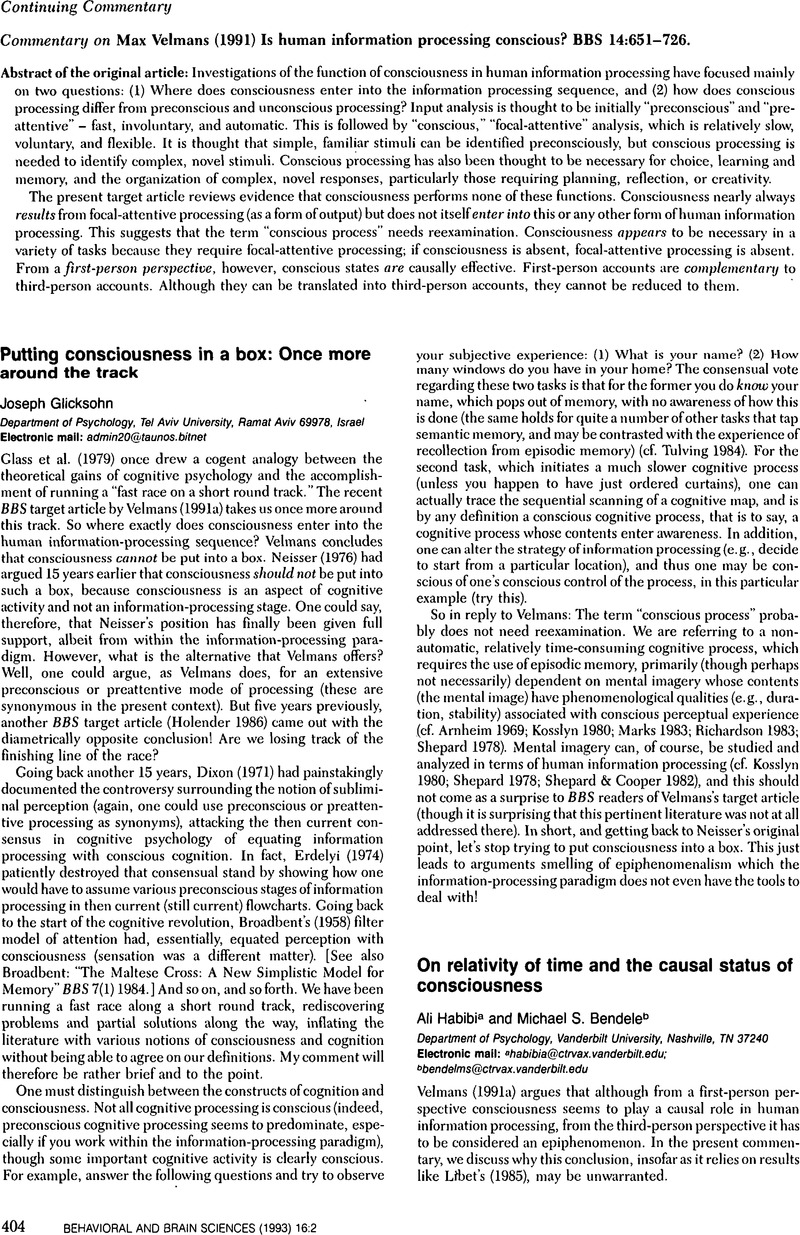Crossref Citations
This article has been cited by the following publications. This list is generated based on data provided by Crossref.
Navon, David
1995.
A-consciousness: The local newspaper of the mind?.
Behavioral and Brain Sciences,
Vol. 18,
Issue. 2,
p.
265.
Bachmann, Talis
1995.
More empirical cases to break the accord of phenomenal and access-consciousness.
Behavioral and Brain Sciences,
Vol. 18,
Issue. 2,
p.
249.
Rey, G.
1995.
Block's philosophical anosognosia.
Behavioral and Brain Sciences,
Vol. 18,
Issue. 2,
p.
266.
Morton, Adam
1995.
Phenomenal and attentional consciousness may be inextricable.
Behavioral and Brain Sciences,
Vol. 18,
Issue. 2,
p.
263.
Block, Ned
1995.
On a confusion about a function of consciousness.
Behavioral and Brain Sciences,
Vol. 18,
Issue. 2,
p.
227.
Baars, Bernard J.
1995.
Evidence that phenomenal consciousness is the same as access consciousness.
Behavioral and Brain Sciences,
Vol. 18,
Issue. 2,
p.
249.
Lycan, William G.
1995.
We've only just begun.
Behavioral and Brain Sciences,
Vol. 18,
Issue. 2,
p.
262.
Church, Jennifer
1995.
Fallacies or analyses?.
Behavioral and Brain Sciences,
Vol. 18,
Issue. 2,
p.
251.
Atkinson, Anthony P.
and
Davies, Martin
1995.
Consciousness without conflation.
Behavioral and Brain Sciences,
Vol. 18,
Issue. 2,
p.
248.
Katz, Leonard D.
1995.
On distinguishing phenomenal consciousness from the representational functions of mind.
Behavioral and Brain Sciences,
Vol. 18,
Issue. 2,
p.
258.
Graham, George
1995.
Guilty consciousness.
Behavioral and Brain Sciences,
Vol. 18,
Issue. 2,
p.
255.
Kitcher, Patricia
1995.
Triangulating phenomenal consciousness.
Behavioral and Brain Sciences,
Vol. 18,
Issue. 2,
p.
259.
Tye, Michael
1995.
Blindsight, orgasm, and representational overlap.
Behavioral and Brain Sciences,
Vol. 18,
Issue. 2,
p.
268.
van Brakel, J.
1995.
Consciousness is not a natural kind.
Behavioral and Brain Sciences,
Vol. 18,
Issue. 2,
p.
269.
Zalla, Tiziana
and
Palma, Adriano P.
1995.
Feeling of knowing and phenomenal consciousness.
Behavioral and Brain Sciences,
Vol. 18,
Issue. 2,
p.
271.
Dixon, N. F.
1995.
Breakthrough on the consciousness front or much ado about nothing?.
Behavioral and Brain Sciences,
Vol. 18,
Issue. 2,
p.
253.
Warren, Richard M.
1995.
Should we continue to study consciousness?.
Behavioral and Brain Sciences,
Vol. 18,
Issue. 2,
p.
270.
Revonsuo, Antti
1995.
Conscious and nonconscious control of action.
Behavioral and Brain Sciences,
Vol. 18,
Issue. 2,
p.
265.
Kobes, Bernard W.
1995.
Access and what it is like.
Behavioral and Brain Sciences,
Vol. 18,
Issue. 2,
p.
260.
Natsoulas, Thomas
1995.
How access-consciousness might be a kind of consiousness.
Behavioral and Brain Sciences,
Vol. 18,
Issue. 2,
p.
264.


